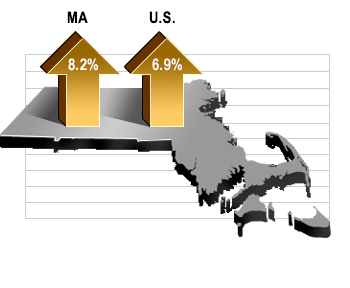Thursday, January 27, 2022

State economy ends 2021 on a high note, UMass journal reports |
|
Outlook is for slower and continued growth but with considerable risks to the downside |

In the fourth quarter of 2021, Massachusetts real gross domestic product (GDP) increased at an 8.2 percent annualized rate, according to MassBenchmarks, while U.S. GDP increased at a 6.9 percent rate according to the U.S. Bureau of Economic Analysis (BEA). In the third quarter, according to the BEA, Massachusetts GDP expanded at a 3.7 percent annual rate while U.S. GDP grew at a 2.3 percent pace.
The strong growth in the fourth quarter reflects in part the respite from COVID infections in the fall. The Delta variant contributed to slower growth in the third quarter, and the Omicron variant began to affect the economy only towards the end of the fourth quarter. Otherwise, the fourth quarter of 2021 was a period of strong employment, income growth, and robust consumer spending, with somewhat stronger performance in Massachusetts than nationally.
Payroll employment in the fourth quarter grew at an annual rate of 6.1 percent in Massachusetts, considerably faster than the 3.6 percent pace for the U.S. This compares with jobs growth of 7.0 percent in Massachusetts and 6.7 percent for the U.S. in the third quarter. Year over year, between the fourth quarters of 2020 and 2021, the number of jobs in Massachusetts grew 6.1 percent, as compared to 4.3 percent for the U.S. Despite this robust growth, the number of jobs in the state remained 4.1 percent below the levels of payroll employment at the pre-pandemic peak (February 2020) at the conclusion of calendar year 2021. The national jobs gap remains 2.3 percent below the February 2020 peak.
The unemployment rate in Massachusetts fell to 3.9 percent in December, from 5.2 percent in September. During the same period, the U.S. unemployment rate fell from 4.8 percent in September to 3.9 percent in December. In December 2020, the unemployment rate was 8.4 percent in Massachusetts and 6.7 percent in the U.S. While labor markets are tight, there is still room for employment growth, if the virus cooperates. The number of unemployed workers in the state stood at 145,000 in December, well above the pre-pandemic level of 105,000 in February 2020, and the labor force participation rate, at 65.4 percent, remains 1.0 percentage point below the February 2020 level.
Massachusetts wage and salary income in the fourth quarter, estimated from state withholding taxes net of unemployment insurance withholding, grew at an 8.6 percent annual rate. This compares with MassBenchmarks' estimate of U.S. wage and salary growth of 8.5 percent in the fourth quarter. According to the BEA, wages and salaries grew at a 12.3 percent annual rate in Massachusetts and 11.4 percent nationally in the third quarter. "The core rate of consumer price inflation–the CPI excluding food and energy–was 2.5 percent in the fourth quarter and 4.0 percent in the third quarter in the Boston metropolitan area, lower than the national CPI of 5.5 percent in the fourth quarter and 5.3 percent in the third quarter," noted Alan Clayton-Matthews, MassBenchmarks' Senior Contributing Editor and Professor Emeritus of Economics and Public Policy at Northeastern University, who compiles and analyzes the Current and Leading Indexes. "This means that in the second half of last year, average real wage and salary income per payroll worker kept up with inflation locally, but nationally lagged behind inflation by almost one percent on an annual basis," Clayton-Matthews added.
Spending on goods subject to the regular state sales taxes and motor vehicle sales taxes rose at a 13.5 percent annual rate in the fourth quarter, after declining by 12.9 percent in the third quarter, a robust pace of spending growth by Massachusetts residents and businesses in the final three months of the year.
In the first half of 2022, the MassBenchmarks Leading Index suggests a moderate slowing in Massachusetts GDP growth from the strong pace of the fourth quarter, but still consistent with continuing economic recovery. The Leading Index is projecting growth of 5.6 percent in the first quarter of this year and 4.6 percent in the second quarter. However, downside risks remain evident. Unease about the future is reflected in weaker consumer confidence and falling stock prices, which in turn reflect concerns about the effect of the virus on the economy, concerns about persistent inflation, and international unrest.
| ADDITIONAL RESOURCES |
|
|
A comprehensive analysis of the state of the Massachusetts economy can be found in the most recent issue of MassBenchmarks. |
|
MassBenchmarks is published by the UMass Amherst Donahue Institute in cooperation with the Federal Reserve Bank of Boston. The UMass Amherst Donahue Institute is the public service, outreach, and economic development unit of the University of Massachusetts. The Current and Leading Indexes are compiled and analyzed by Dr. Alan Clayton-Matthews, Professor Emeritus of Economics & Public Policy at Northeastern University and released quarterly by MassBenchmarks.
![]()
For more information please contact:
|
|
|||
|
|
|
||
![]()
![]()
